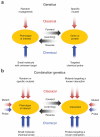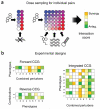Combination chemical genetics
- PMID: 18936752
- PMCID: PMC2712875
- DOI: 10.1038/nchembio.120
Combination chemical genetics
Abstract
Predicting the behavior of living organisms is an enormous challenge given their vast complexity. Efforts to model biological systems require large datasets generated by physical binding experiments and perturbation studies. Genetic perturbations have proven important and are greatly facilitated by the advent of comprehensive mutant libraries in model organisms. Small-molecule chemical perturbagens provide a complementary approach, especially for systems that lack mutant libraries, and can easily probe the function of essential genes. Though single chemical or genetic perturbations provide crucial information associating individual components (for example, genes, proteins or small molecules) with pathways or phenotypes, functional relationships between pathways and modules of components are most effectively obtained from combined perturbation experiments. Here we review the current state of and discuss some future directions for 'combination chemical genetics', the systematic application of multiple chemical or mixed chemical and genetic perturbations, both to gain insight into biological systems and to facilitate medical discoveries.
Figures




Similar articles
-
The Yeast Systems Biology Network: mating communities.Curr Opin Biotechnol. 2005 Jun;16(3):356-60. doi: 10.1016/j.copbio.2005.04.006. Curr Opin Biotechnol. 2005. PMID: 15961037 Review.
-
Allele-specific behavior of molecular networks: understanding small-molecule drug response in yeast.PLoS One. 2013;8(1):e53581. doi: 10.1371/journal.pone.0053581. Epub 2013 Jan 4. PLoS One. 2013. PMID: 23308257 Free PMC article.
-
Editorial: Accelerating systems biology.Brief Bioinform. 2010 May;11(3):267-9. doi: 10.1093/bib/bbq012. Brief Bioinform. 2010. PMID: 20478854 No abstract available.
-
The end of "naive reductionism": rise of systems biology or renaissance of physiology?Am J Physiol Cell Physiol. 2005 May;288(5):C968-74. doi: 10.1152/ajpcell.00598.2004. Am J Physiol Cell Physiol. 2005. PMID: 15840560 Review.
-
Predicting phenotypic effects of gene perturbations in C. elegans using an integrated network model.Bioessays. 2008 Aug;30(8):707-10. doi: 10.1002/bies.20783. Bioessays. 2008. PMID: 18618771 Review.
Cited by
-
Discovering anti-platelet drug combinations with an integrated model of activator-inhibitor relationships, activator-activator synergies and inhibitor-inhibitor synergies.PLoS Comput Biol. 2015 Apr 15;11(4):e1004119. doi: 10.1371/journal.pcbi.1004119. eCollection 2015 Apr. PLoS Comput Biol. 2015. PMID: 25875950 Free PMC article.
-
Cross-species discovery of syncretic drug combinations that potentiate the antifungal fluconazole.Mol Syst Biol. 2011 Jun 21;7:499. doi: 10.1038/msb.2011.31. Mol Syst Biol. 2011. PMID: 21694716 Free PMC article.
-
How drugs get into cells: tested and testable predictions to help discriminate between transporter-mediated uptake and lipoidal bilayer diffusion.Front Pharmacol. 2014 Oct 31;5:231. doi: 10.3389/fphar.2014.00231. eCollection 2014. Front Pharmacol. 2014. PMID: 25400580 Free PMC article. Review.
-
Efficient discovery of anti-inflammatory small-molecule combinations using evolutionary computing.Nat Chem Biol. 2011 Oct 23;7(12):902-8. doi: 10.1038/nchembio.689. Nat Chem Biol. 2011. PMID: 22020553 Free PMC article.
-
Adding more content to screening: reactivation of FOXO as a therapeutic strategy.Clin Transl Oncol. 2009 Oct;11(10):651-8. doi: 10.1007/s12094-009-0420-0. Clin Transl Oncol. 2009. PMID: 19828407 Review.
References
-
- Stelling J, Sauer U, Szallasi Z, Doyle FJ, III, Doyle J. Robustness of cellular functions. Cell. 2004;118:675–685. - PubMed
-
- Koonin EV, Wolf YI, Karev GP. The structure of the protein universe and genome evolution. Nature. 2002;420:218–223. - PubMed
-
- Hood L, Heath JR, Phelps ME, Lin B. Systems biology and new technologies enable predictive and preventative medicine. Science. 2004;306:640–643. - PubMed
-
- Davidson EH, et al. A genomic regulatory network for development. Science. 2002;295:1669–1678. - PubMed
-
- Silva JM, et al. Second-generation shRNA libraries covering the mouse and human genomes. Nat. Genet. 2005;37:1281–1288. - PubMed
Publication types
MeSH terms
Grants and funding
LinkOut - more resources
Full Text Sources
Other Literature Sources
Molecular Biology Databases

